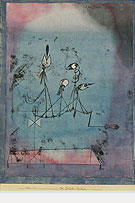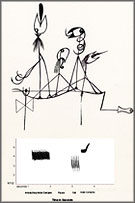
Plate 41
|

Plate 42
|
|
to the pit over which the machine hovers. We can imagine the fiendish cacophony made by the shrieking birds, their legs drawn thin and taut as they strain against the machine to which they are fused.”[11]
The bird on the left, the one with a tail, is not shackled and might represent a real bird, but we suggest an alternative interpretation of Klee’s mechanistic view of song production.
Viewing the Science
This expressionist painting hung for five years in the National Gallery in Berlin before Adolf Hitler proclaimed it degenerate. We see it not as degenerate but as imaginative and as a step ahead of science in portraying the “score” of a birdsong: we can view the heads of the birds as the points on a sound spectrograph representing the phrasing and frequency of a vocal exchange, or as perhaps the heads of musical notes (Plate 42).
Art critics interpreting this painting have sometimes considered it a contemptuous satire of laboratory science. John Adkins Richardson wrote that Klee’s “picture is of a machine for producing birdsong; one turns the crank handle and the birds tweet grotesquely, jerking up and down on a sine curve.”[12] On the other hand, it could be interpreted
page 3--> |
Plate 41 Twittering Machine (Zwitscher-Maschine), 1922, 151, by Paul Klee. The Museum of Modern Art, New York, NY. Mrs. John D. Rockefeller Jr. Purchase Fund. Photo credit: Digital Image © The Museum of Modern Art. Licensed by SCALA/Art Resource, NY. © 2007 Artists Rights Society (ARS), New York
Plate 42 Drawing Based on a Detail from Paul Klee’s “Twittering Machine” with Sonogram, © 1995/2007 Darryl Wheye.Science Art--Birds.
© 2008 Darryl Wheye and Donald Kennedy
|


